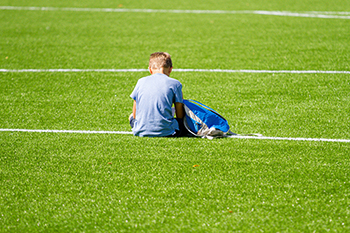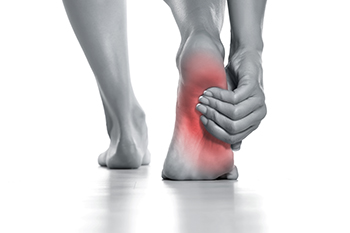August 2024
Bunions and Relief Methods

A bunion is a bony bump that forms at the base of the big toe, causing it to lean inward toward the other toes. This condition, also known as hallux valgus, develops gradually and is often aggravated by wearing tight shoes or genetic predisposition. Bunions can lead to pain, swelling, and difficulty fitting into shoes comfortably. Relief methods focus on managing symptoms and preventing further progression. Wearing shoes with a wide toe box and low heels reduces pressure on the bunion. Padded shoe inserts or orthotics can provide additional support and alignment for the foot. If you have developed a painful bunion, it is suggested that you contact this type of doctor who can target specific treatment methods that are right for you, which may include surgery for permanent removal.
If you are suffering from bunion pain, contact Milos Tomich, DPM of Dr. Tomich Foot & Ankle Health Center. Our doctor can provide the care you need to keep you pain-free and on your feet.
What Is a Bunion?
Bunions are painful bony bumps that usually develop on the inside of the foot at the joint of the big toe. As the deformity increases over time, it may become painful to walk and wear shoes. Women are more likely to exacerbate existing bunions since they often wear tight, narrow shoes that shift their toes together. Bunion pain can be relieved by wearing wider shoes with enough room for the toes.
Causes
- Genetics – some people inherit feet that are more prone to bunion development
- Inflammatory Conditions - rheumatoid arthritis and polio may cause bunion development
Symptoms
- Redness and inflammation
- Pain and tenderness
- Callus or corns on the bump
- Restricted motion in the big toe
In order to diagnose your bunion, your podiatrist may ask about your medical history, symptoms, and general health. Your doctor might also order an x-ray to take a closer look at your feet. Nonsurgical treatment options include orthotics, padding, icing, changes in footwear, and medication. If nonsurgical treatments don’t alleviate your bunion pain, surgery may be necessary.
If you have any questions, please feel free to contact one of our offices located in Milwaukee and Wauwatosa, WI . We offer the newest diagnostic and treatment technologies for all your foot care needs.
Why Live with Pain and Numbness in Your Feet?
Shin Splints and the Feet
 Shin splints, medically known as medial tibial stress syndrome, are a common condition resulting in pain along the inner edge of the shinbone, or tibia. This pain typically results from repetitive stress on the shinbone and the connective tissues that attach muscles to the bone from the ankle. Runners, dancers, and athletes who engage in high-impact activities are particularly at risk. The condition often occurs due to overuse, wearing improper footwear, or sudden increases in physical activity. Flat feet or abnormally high arches can worsen shin splints by causing improper alignment and distribution of stress during movement. Treatment for shin splints includes rest and anti-inflammatory medications to reduce pain and swelling. Stretching and strengthening exercises, along with wearing proper footwear, can prevent recurrence. A podiatrist can provide valuable assistance by evaluating your foot biomechanics and recommending custom orthotics to improve alignment and reduce stress on the tibia. If you have shin splints, it is suggested that you schedule an appointment with this type of doctor for care.
Shin splints, medically known as medial tibial stress syndrome, are a common condition resulting in pain along the inner edge of the shinbone, or tibia. This pain typically results from repetitive stress on the shinbone and the connective tissues that attach muscles to the bone from the ankle. Runners, dancers, and athletes who engage in high-impact activities are particularly at risk. The condition often occurs due to overuse, wearing improper footwear, or sudden increases in physical activity. Flat feet or abnormally high arches can worsen shin splints by causing improper alignment and distribution of stress during movement. Treatment for shin splints includes rest and anti-inflammatory medications to reduce pain and swelling. Stretching and strengthening exercises, along with wearing proper footwear, can prevent recurrence. A podiatrist can provide valuable assistance by evaluating your foot biomechanics and recommending custom orthotics to improve alignment and reduce stress on the tibia. If you have shin splints, it is suggested that you schedule an appointment with this type of doctor for care.
Ankle and foot injuries are common among athletes and in many sports. They can be caused by several problems and may be potentially serious. If you are feeling pain or think you were injured in a sporting event or when exercising, consult with Milos Tomich, DPM from Dr. Tomich Foot & Ankle Health Center. Our doctor will assess your condition and provide you with quality foot and ankle treatment.
Common Injuries
The most common injuries that occur in sporting activities include:
- Achilles Tendonitis
- Achilles Tendon Rupture
- Ankle Sprains
- Broken Foot
- Plantar Fasciitis
- Stress Fractures
- Turf Toe
Symptoms
Symptoms vary depending upon the injury and in some cases, there may be no symptoms at all. However, in most cases, some form of symptom is experienced. Pain, aching, burning, bruising, tenderness, tightness or stiffness, sensation loss, difficulty moving, and swelling are the most common symptoms.
Treatment
Just as symptoms vary depending upon the injury, so do treatment options. A common treatment method is known as the RICE method. This method involves rest, applying ice, compression and elevating the afflicted foot or ankle. If the injury appears to be more serious, surgery might be required, such as arthroscopic or reconstructive surgery. Lastly, rehabilitation or therapy might be needed to gain full functionality in the afflicted area. Any discomfort experienced by an athlete must be evaluated by a licensed, reputable medical professional.
If you have any questions, please feel free to contact one of our offices located in Milwaukee and Wauwatosa, WI . We offer the newest diagnostic and treatment technologies for all your foot care needs.
Proper Footwear for Restaurant Workers

Proper footwear is essential for restaurant workers as a way of maintaining health and comfort throughout long shifts. These jobs often involve extended periods of standing and walking on hard surfaces, which can lead to foot, leg, and back pain if the right shoes are not worn. Proper footwear provides necessary support, cushioning, and stability, helping to absorb shock and reduce the risk of injuries such as sprains or stress fractures. Shoes with slip-resistant soles also enhance safety by preventing slips and falls in potentially hazardous kitchen environments. Additionally, wearing well-fitted, supportive shoes can help alleviate common issues like plantar fasciitis and bunions. Investing in high-quality, ergonomic footwear ensures that restaurant workers remain comfortable and protected. If you work in the restaurant industry and have endured a foot injury or have developed chronic foot pain, it is suggested that you speak with a podiatrist. This type of doctor can offer effective treatment options, in addition to guiding you toward wearing appropriate footwear for the job.
While working on the feet, it is important to take the proper care of them. For more information about working on your feet, contact Milos Tomich, DPM from Dr. Tomich Foot & Ankle Health Center. Our doctor will treat your foot and ankle needs.
Working on Your Feet
Standing on your feet for long periods of time can cause stress and pain in your feet. Your whole body may experience change in terms of posture, back pain, bunions, callouses and or plantar warts. There are ways to avoid these conditions with proper foot care, smart choices and correct posture.
Positive Changes
Negative heeled shoe – Choosing this shoe type places the heel slightly lower than the ball of the foot. These are great for overall foot health. Find shoes that fit you correctly.
Go barefoot – Our feet were not designed to be enclosed for all hours of the day. Try to periodically expose your feet to air.
Eliminate Pain
Foot Exercises – Performing simple exercises, incorporating yoga and doing stretches are beneficial. This will allow increased blood flow to the area and muscles of the foot.
Achilles tendon – Stretching the foot out flat on the floor will relax the calf muscles and tendon. These exercises can be performed almost anywhere. Make sure you add these exercises to your daily regimen.
With a little bit of this information and knowing more about foot health, you will notice changes. Foot stretches and proper footwear will help with pain and prevent further issues.
If you have any questions please feel free to contact one of our offices located in Milwaukee and Wauwatosa, WI . We offer the newest diagnostic and treatment technologies for all your foot and ankle needs.
Various Causes of Heel Pain

There are many types of disorders that cause pain in the heel. The most common cause of heel pain is plantar fasciitis, an inflammation of the plantar fascia tissue that runs along the bottom of the foot. Other common sources of heel pain include a calcaneal, or heel bone, fracture, and heel pad syndrome, which is a wearing down of the cushion on the bottom of the heel. Other causes of heel pain are nerve entrapment, including tarsal tunnel syndrome, which can also cause tingling, numbness or burning, and neuromas, or nerve swelling. Achilles tendinopathy, or damage to the tendon that attaches the calf muscles to the heel bone, may result in heel pain. Growing active children may be prone to Sever’s disease, which is irritation in the growth plate of the heel. A podiatrist will typically begin an evaluation by asking where the pain is located, along with some family medical history questions followed by a physical examination. This foot doctor may use various diagnostic tools to determine the underlying cause of your heel pain and how best to treat it. If you have heel pain, it’s suggested that you make an appointment with a podiatrist.
Many people suffer from bouts of heel pain. For more information, contact Milos Tomich, DPM of Dr. Tomich Foot & Ankle Health Center. Our doctor can provide the care you need to keep you pain-free and on your feet.
Causes of Heel Pain
Heel pain is often associated with plantar fasciitis. The plantar fascia is a band of tissues that extends along the bottom of the foot. A rip or tear in this ligament can cause inflammation of the tissue.
Achilles tendonitis is another cause of heel pain. Inflammation of the Achilles tendon will cause pain from fractures and muscle tearing. Lack of flexibility is also another symptom.
Heel spurs are another cause of pain. When the tissues of the plantar fascia undergo a great deal of stress, it can lead to ligament separation from the heel bone, causing heel spurs.
Why Might Heel Pain Occur?
- Wearing ill-fitting shoes
- Wearing non-supportive shoes
- Weight change
- Excessive running
Treatments
Heel pain should be treated as soon as possible for immediate results. Keeping your feet in a stress-free environment will help. If you suffer from Achilles tendonitis or plantar fasciitis, applying ice will reduce the swelling. Stretching before an exercise like running will help the muscles. Using all these tips will help make heel pain a condition of the past.
If you have any questions please contact one of our offices located in Milwaukee and Wauwatosa, WI . We offer the newest diagnostic and treatment technologies for all your foot and ankle needs.





